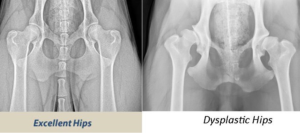WHAT IS CANINE HIP DYSPLASIA?
Hip dysplasia is a common orthopedic condition seen in dogs, where there is poor congruency ( fitting together) of the ball and socket joint in the hip. It is estimated that between 15-20% of all dogs have some degree of hip dysplasia, but it often goes undiagnosed if the symptoms are not significant enough to cause signs of pain or lameness in the dog.
Due to this poor congruency, there is excess motion in the hip joint as the dog moves. This motion will cause rubbing and friction, leading to pain, and eventually, arthritic changes in the hip. It can be a devastating thing for an owner to hear that their dog has been diagnosed with hip dysplasia, but the majority of dogs can live a good quality of life with conservative management. Even dogs diagnosed with severe hip dysplasia are not always in a lot of pain or even that symptomatic. There are many non-surgical options available to owners with dogs with hip dysplasia, including supplements and medications, physical rehabilitation and hip garments/supports. The best results will be obtained when the plan is a multi-modal approach, meaning taking some action from each of the areas mentioned above. The medications and supplements will keep the joint healthy and keep the pain level managed, physical rehabilitation can help with pain management and maintaining/improving muscle development, and the therapeutic garments/supports can help to minimize symptoms as the dog moves.
The K9 HipLign™ was designed as a therapeutic garment to help minimize symptoms in dogs with hip dysplasia and other similar issues. It is a breathable, lightweight garment that works by stimulating the dog’s proprioceptive system ( our awareness of where we are in space) to help enhance more normal posture. In addition, there are 4 elastic straps which provide a light balanced resistance to the dog’s hip muscles as they move. Over time, with regular use, this will improve dynamic stability to the hips, which can help minimize symptoms. The K9 HipLign™ is non-invasive, does not restrict normal movement, and treats both hips at the same time. It can be used as part of a rehabilitation program, or can be used for treatment at home.

In the image on the left, you can see the head ( “ball”) of the femur is smooth and rounded, and fits snugly into the “cup” of the acetabulum. In the image on the right, the heads of the femur are flattened and irregular in shape, and there is a poor fit between the “ball” and “cup” in the joint.
TOP 5 THINGS YOU CAN DO TO HELP YOUR DOG MANAGE ITS HIP DYSPLASIA SYMPTOMS
- Discuss with your pet’s veterinarian about appropriate supplements and/or medications to help support joint health and manage your pet’s pain levels.
- Keep your pet at a lean, healthy weight. You should be able to feel their ribs fairly easily when you rub along the sides of their trunk, and when viewed from the side, they should have a tuck up from their chest to their abdomen.
- Keep your pet moderately active- try to keep their activity level about the same every day. Avoid “weekend warrior” syndrome, where they only go for short walks during the weekdays, then have much longer/more strenuous activity on the weekends- this can lead to flare ups of symptoms.
- Keep your pet moving and active, but minimize explosive/high impact activities, to minimize the stress on their joints. It is important to keep their muscles in good condition, to help support the hip joints, but do more walking, swimming and other low-impact activities vs. fetch, running and other more explosive activities.
- Look into alternative therapies in your area, including acupuncture, laser therapy and rehabilitation services. These treatments can be very helpful to maintain comfort and educate you in management strategies at home to keep your pet moving well.

Contact us
P: (213) 927-6663
E: Contact@k9motion.com
W: K9motion.com